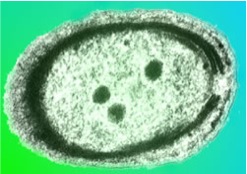
Prochlorococcus is one of the ocean’s most abundant primary producers.
(Claire Ting, Department of Biology, Williams College)
Prochlorococcus count among the most abundant species of tiny cyanobacteria in the oceans. An estimated 100 million cells of this unicellular organism can be found in a single liter of seawater, and these cyanobacteria help remove some 10 billion tons of carbon from the atmosphere every year.
A long-held assumption has been that the size of an microbial population in the marine community corresponds to its level of activity in terms of carbon uptake, growth rate, etc., thus determining its impact on global biogeochemical cycles. To test this theory, several researchers including scientists at the DOE Joint Genome Institute employed studied the activity levels of several marine microbes from the North Pacific Ocean and compared them to samples from the Pacific and the Sargasso Sea.The results appeared online October 19, 2012 in Appliedand Environmental Microbiology.
The DOE JGI has published the genomes of several Prochlorococcus strains as part of the Community Sequencing Program. Since the organism is well-studied, the team wanted to see if the expected relationship between the microbe’s population and its activity levels could be decoupled.
“Our results suggest that low abundance microbes may be disproportionately active in certain environments and that some of the most abundant may have low metabolic activity,” the researchers concluded. “We observed uncoupling of abundance and specific activity of Prochlorococcus in the Sargasso Sea depth profile, which highlights deficiencies in our understanding of marine microbial ecology and population structure.”